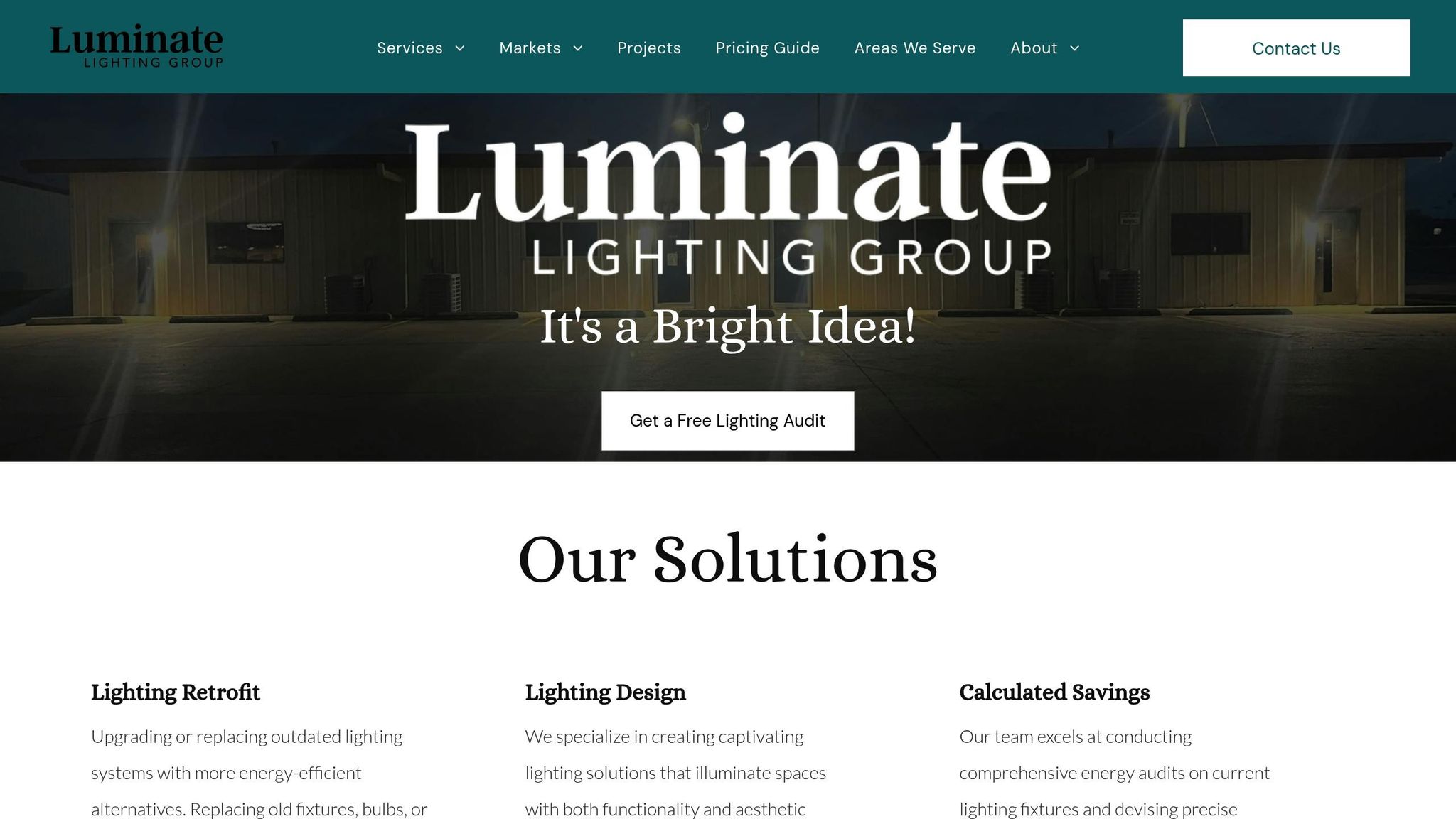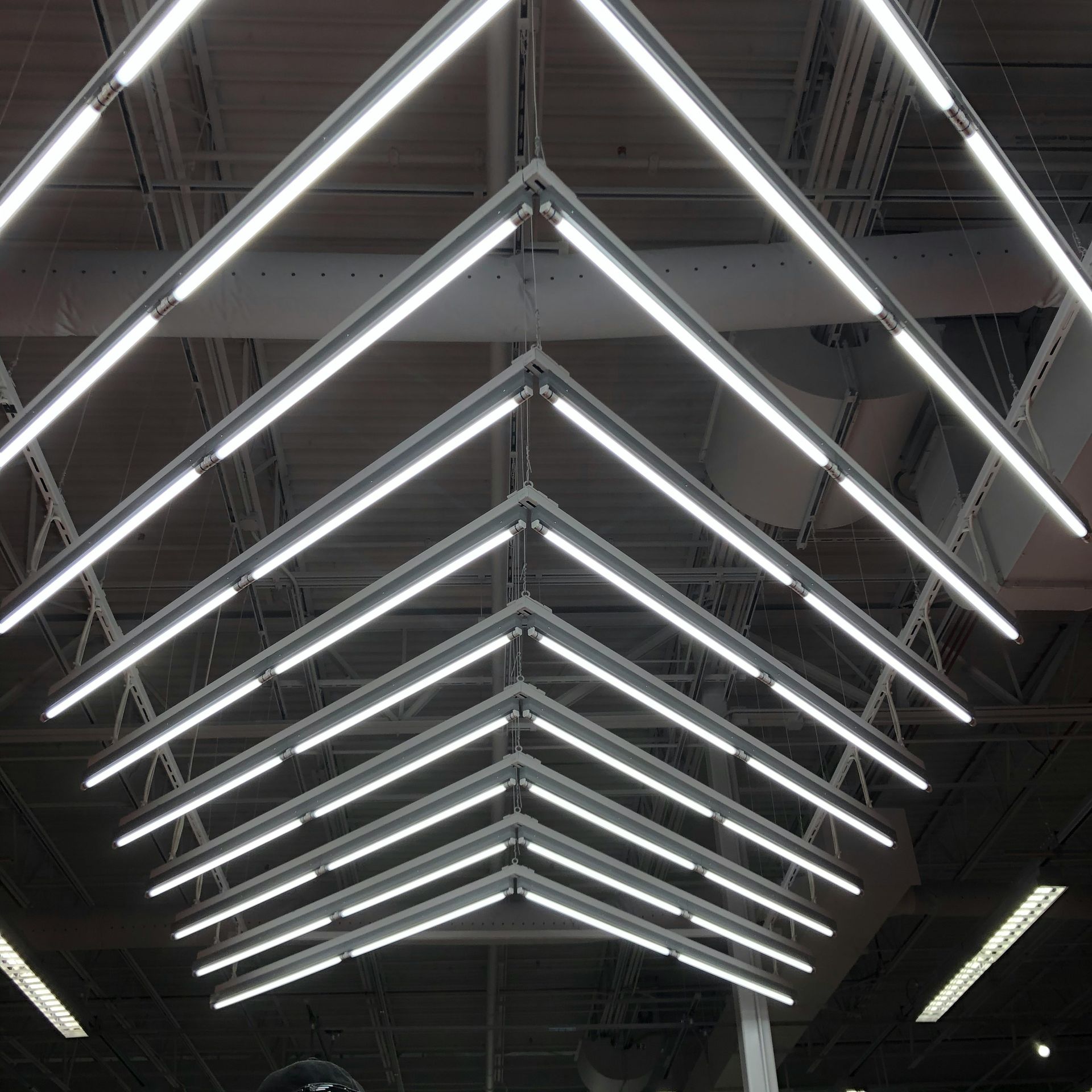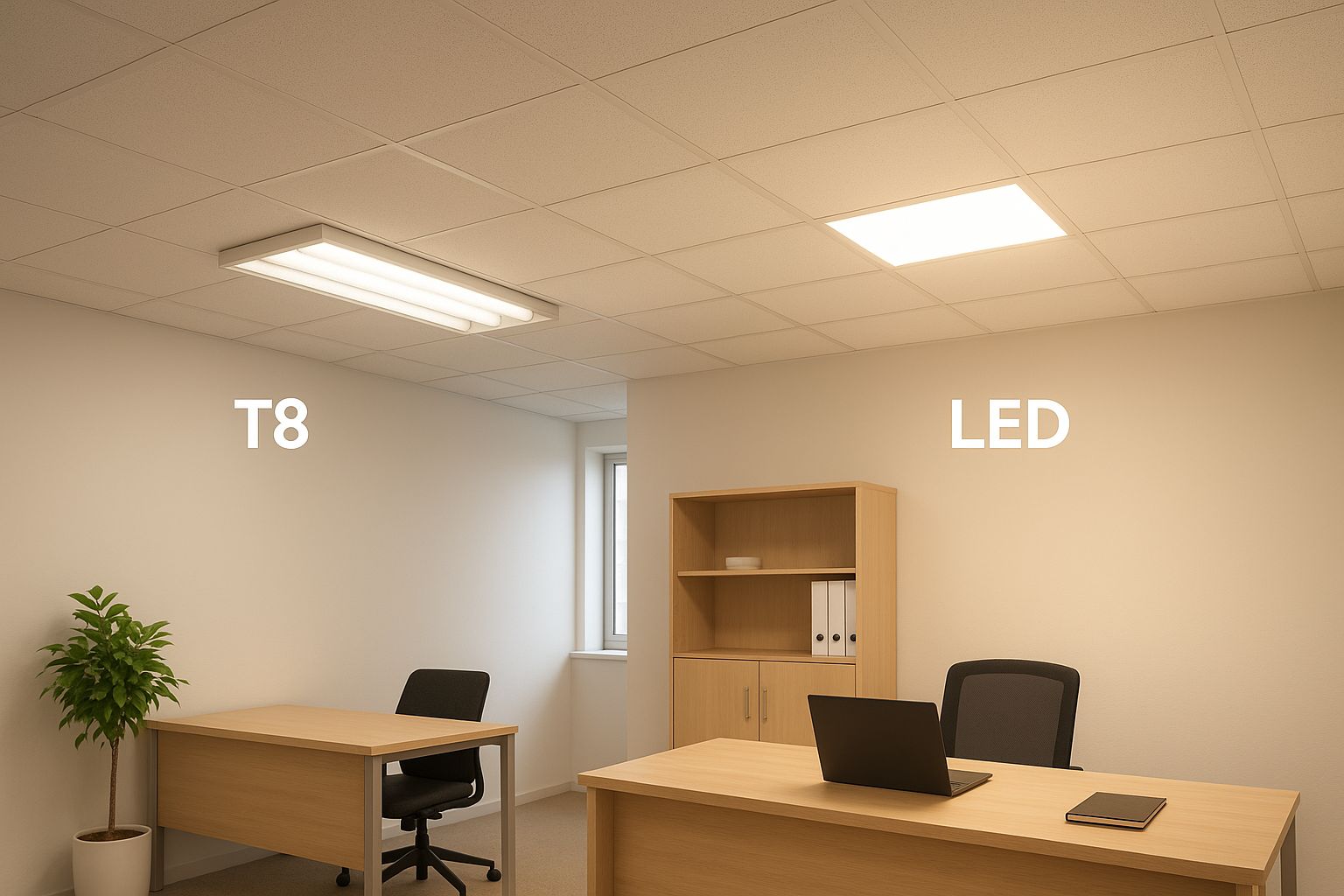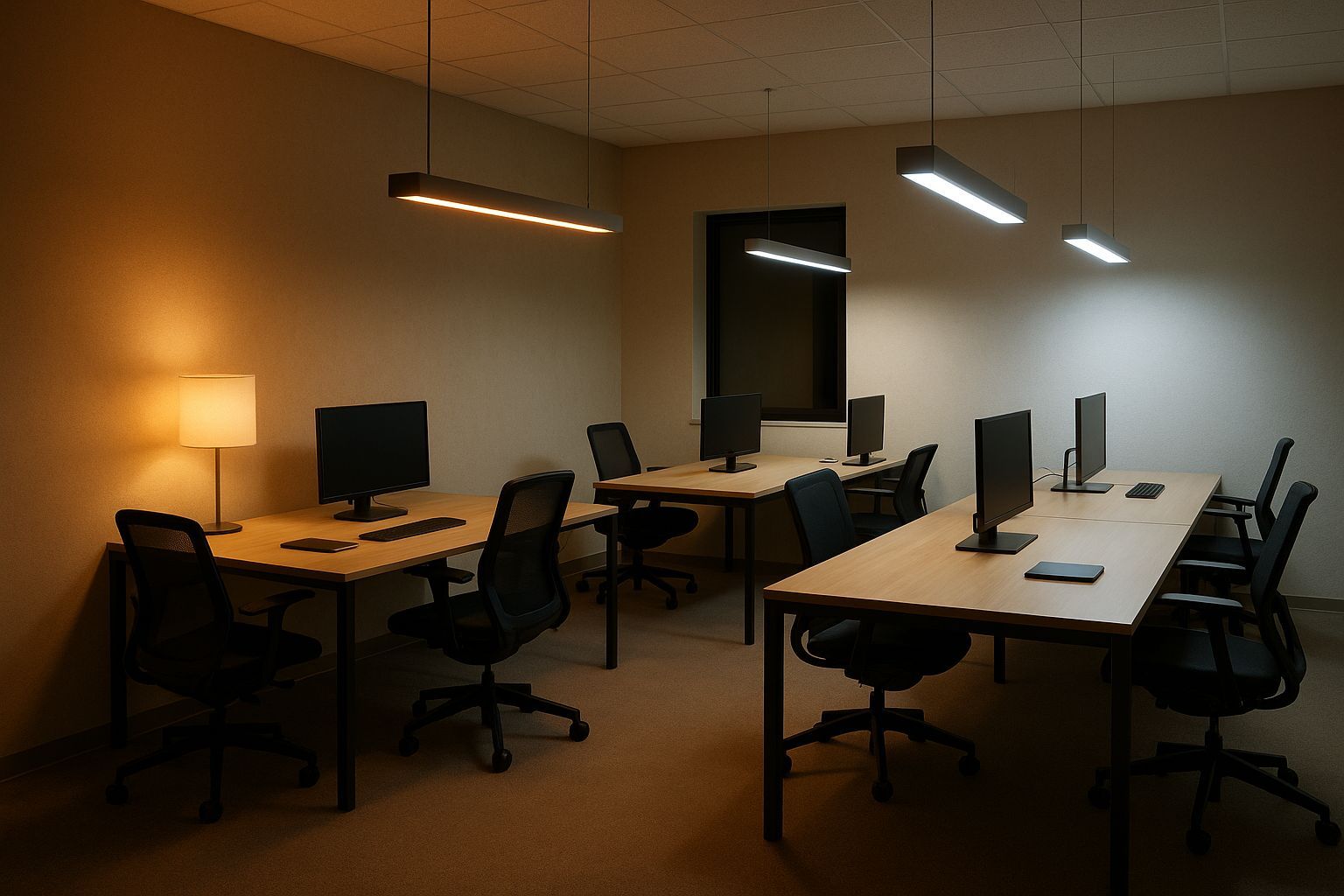LED Retrofit ROI: 5 Ways to Calculate Savings
LED Retrofit ROI: 5 Ways to Calculate Savings
LED retrofits are a practical way to upgrade lighting systems, significantly cutting energy and maintenance costs while improving efficiency. LEDs use up to 75% less energy than incandescent bulbs and last up to 50,000 hours, compared to just 1,000–10,000 hours for older lighting options. This translates into lower utility bills, reduced maintenance efforts, and even tax incentives or rebates.
To calculate the return on investment (ROI) for an LED retrofit, you need to consider:
- Project Costs: Includes LED fixtures, labor, disposal, and additional materials like smart controls.
- Energy Savings: Measure the difference in energy consumption between your current setup and the proposed LED system.
- Rebates and Incentives: Utility rebates and tax credits can offset up to 50% of the costs.
- Maintenance Savings: LEDs require fewer replacements, reducing upkeep costs significantly.
You can evaluate ROI using five methods:
- Simple Payback Period: Time it takes to recover costs through savings.
- ROI Percentage: Measures profitability as a percentage.
- Net Present Value (NPV): Considers the value of future savings over time.
- Internal Rate of Return (IRR): Calculates the annual return rate of the investment.
- Life-Cycle Cost Analysis (LCCA): Accounts for all costs and savings over the system's lifespan.
For example, a 20,000-square-foot warehouse reduced its retrofit cost from $35,000 to $25,000 with incentives, achieving a payback period of just 1.8 years. By combining these methods, you can assess financial benefits and optimize savings for your LED retrofit.
How to Accurately Calculate LED Lighting Retrofit Savings
Understanding the Total Project Investment
Before diving into ROI calculations, it’s essential to understand the full scope of your LED retrofit investment. The total project cost isn’t just about buying LED fixtures - it includes several key components that can significantly impact your budget and payback timeline.
Key Investment Components
Your LED retrofit investment typically falls into five main categories: LED fixtures, installation labor, engineering/design fees, disposal/recycling, and additional materials. Let’s break these down:
- LED Fixtures: These are often the largest expense, with prices ranging from $0.50 to $5.00 per square foot depending on the type and quality. For instance, outfitting a 10,000-square-foot facility could cost anywhere from $5,000 to $50,000 just for the fixtures.
- Installation Labor: Labor costs make up 30-50% of the total project. This includes removing old fixtures, installing the new LEDs, and performing any necessary wiring updates. For example, at $50 per hour, 120 hours of labor would add $6,000 to your total investment.
- Engineering and Design Fees: Expect to spend $1,000 to $5,000 or more on these fees for commercial projects. These costs cover lighting assessments, photometric analysis, and ensuring compliance with building codes and performance standards.
- Disposal and Recycling: Removing old equipment, especially hazardous materials like ballasts containing PCBs, can cost anywhere from $500 to $2,000 depending on the size of your facility.
- Additional Materials: Items like smart controls, occupancy sensors, or upgraded wiring can add $2,000 or more. While these increase upfront costs, they often qualify for rebates and contribute to long-term savings.
Here’s an example breakdown of a $28,000 LED retrofit project:
| Cost Component | Amount | Percentage of Total |
|---|---|---|
| LED Fixtures (300 units at $60 each) | $18,000 | 64% |
| Installation Labor (120 hours at $50/hour) | $6,000 | 21% |
| Engineering/Design Fees | $1,500 | 5% |
| Disposal/Recycling | $500 | 2% |
| Additional Materials/Controls | $2,000 | 7% |
| Total Investment | $28,000 | 100% |
Once you’ve accounted for all these costs, it’s time to explore rebates and incentives to reduce your net investment.
Including Rebates and Incentives
After determining your initial costs, look into utility rebates and tax incentives that can significantly lower your expenses. These programs, designed to promote energy-efficient upgrades, can reduce your costs by 20-50% or more.
- Utility Rebates: These provide immediate cash back based on the number of fixtures replaced or the energy savings achieved. Many utility companies also offer expedited rebate processing for businesses.
- Tax Incentives: Federal and state programs often provide tax credits for energy-efficient equipment or allow for accelerated depreciation, enhancing your project’s financial outlook.
To find available programs, start by checking your utility provider’s website or visit the Database of State Incentives for Renewables & Efficiency (DSIRE). Many LED retrofit contractors also assist with rebate applications, ensuring you don’t miss any opportunities.
Here’s a real-world example: A 20,000-square-foot warehouse faced a total LED retrofit cost of $35,000. By securing $7,000 in utility rebates, they reduced their net investment to $28,000. With annual energy and maintenance savings of $19,360, their payback period dropped to just 1.8 years.
Now, imagine that same project also qualified for $3,000 in federal tax credits. The net investment would shrink further to $25,000, improving the ROI and shortening the payback period even more.
When planning your retrofit, always research and apply for available rebates and incentives before finalizing your budget. This ensures you’re working with accurate numbers and maximizing savings from the start.
Calculating Direct Energy Savings
Once you've determined your total project cost, the next step is calculating your electricity bill savings. This involves comparing your current energy consumption to what you'll use after implementing LED retrofits. To get accurate results, you'll need detailed information about your existing lighting setup - this includes the type of fixtures, their actual operating wattage (factoring in ballast losses), and the hours they run each day. Reliable baseline data, such as that collected from data loggers or occupancy studies, is crucial for these calculations. These numbers will also play a key role when you later assess savings from reduced maintenance and operating costs.
Energy Savings Formula
Here's the formula to estimate your annual energy savings:
(Existing Watts – LED Watts) × Hours of Operation × Number of Fixtures ÷ 1,000
This formula gives you the annual kWh savings.
Let’s look at an example. Delta Wye Electric worked with a warehouse that had 100 fixtures. They replaced 458W metal halide fixtures with 150W LED fixtures. These lights operated for 4,380 hours annually. Here's how the math worked out:
- Wattage difference: 458W – 150W = 308W per fixture
- Annual savings per fixture: 308W × 4,380 hours ÷ 1,000 = 1,349 kWh
- Total annual savings: 1,349 kWh × 100 fixtures = 134,904 kWh
This retrofit reduced the warehouse’s lighting energy consumption by 67%.
For fluorescent systems, don’t forget to account for ballast losses, which can add 10–15% to the actual wattage used. For instance, a 32W T8 fluorescent fixture might consume closer to 37W due to ballast losses. And as fixtures age, they may produce less light while still consuming the same amount of energy.
Energy Cost Comparison Table
Using the warehouse example above, with an electricity rate of $0.12 per kWh, the 134,904 kWh savings translated into $16,188 in annual energy savings. This kind of direct energy savings calculation is a critical first step in determining the ROI for an LED retrofit.
Here’s another example: a Southern California aerospace parts manufacturer operating 24/7 replaced 450 metal halide high-bays (1,000W each) and 3,200 fluorescent fixtures with LED equivalents. Their annual energy consumption dropped from 5.2 million kWh to 1.56 million kWh, saving them $442,000 per year- a 70% reduction.
"At Delta Wye Electric, we've helped over 500 industrial facilities calculate and achieve LED energy savings, with documented reductions averaging 50-90% on lighting costs."
Keep in mind that your actual savings will depend on your electricity rate structure. Rates can vary based on demand charges and time-of-use factors. Additionally, LEDs often have a higher power factor (around 0.95 or more, compared to 0.85–0.90 for traditional lighting), and they produce significantly less heat, which can reduce HVAC loads.
For the most accurate projections, review 6–12 months of utility bills. This will help you account for seasonal fluctuations in energy consumption and rates, giving you a solid foundation to estimate savings and build a compelling case for your LED retrofit. Once you've calculated your energy savings, you can move on to evaluating how reduced maintenance and operating costs will further enhance your ROI.
Maintenance and Operating Cost Savings
Switching to LED lighting doesn’t just save energy - it also slashes maintenance and operating expenses. These savings amplify the financial benefits of your retrofit, making it a smarter investment overall.
Maintenance Cost Reductions
One of the biggest perks of LEDs is their long lifespan. With a lifespan of up to 50,000 hours - compared to just 1,000 to 10,000 hours for incandescent and fluorescent bulbs - LEDs require far fewer replacements. Some high-quality commercial-grade LEDs are even rated for 35,000 to 100,000 hours of use.
This durability means fewer maintenance visits. Traditional lighting systems like CFLs and incandescent bulbs often need frequent replacements, especially in hard-to-reach areas. LEDs, on the other hand, can last for decades without needing attention. Plus, they eliminate the need for ballast or striker replacements, a common maintenance headache with fluorescent systems.
"LED lights not only shine brighter and last longer, they also save you money on your energy bill! However, did you know you save even more money on LEDs, thanks to reduced maintenance costs?" - Sitler's LED Supplies
For example, a food distribution facility with a -10°F freezer environment retrofitted 800 fixtures with LED lighting. This change wiped out $180,000 in annual maintenance costs, as the LED fixtures, rated for operation at -40°F, showed zero temperature-related failures over three years. Their old fluorescent system, by contrast, required constant upkeep.
Cities have also seen impressive savings. LED streetlights cut repair and replacement costs by 60–75%, saving municipalities $50–$100 per light annually. These savings free up funds for other important projects without compromising lighting quality. And since LEDs generate less heat, they also reduce operating costs.
Operating Savings from Efficiency
LEDs aren’t just easier to maintain - they’re also more efficient, which lowers operating expenses. Unlike traditional lighting, LEDs produce minimal heat, reducing the strain on HVAC systems. For context, incandescent bulbs waste 90% of their energy as heat, and CFLs lose about 80%. LEDs, by comparison, emit very little heat.
Take a 100,000-square-foot industrial facility as an example. If it uses conventional 400W metal halide high bay fixtures, these lights generate around 69,400 watts of waste heat that the HVAC system has to remove. Switching to 150W LED high bays cuts that waste heat to about 30,000 watts - a 57% reduction. This translates to a cooling load drop of 134,464 BTU/hr, potentially reducing the building’s overall cooling needs by 25%.
The savings can be dramatic. An aerospace manufacturer saw its monthly demand charges plummet from $28,000 to $8,400 - a 70% decrease - after installing LEDs, thanks in part to the reduced HVAC load. Universities have reported up to 75% reductions in campus-wide energy use with LED lighting, much of it due to lower cooling demands. Large municipal buildings, too, can save six figures annually on electricity bills, with HVAC-related savings making up a significant chunk of those reductions.
When calculating your potential savings, it’s essential to consider your facility’s unique conditions. Cold environments often boost LED performance, while areas with high temperatures benefit most from reduced cooling loads. Don’t forget to factor in local electricity rates, HVAC usage, and current maintenance costs to get a clear picture of how LEDs can improve your return on investment.
sbb-itb-86fe545
5 Methods to Calculate LED Retrofit ROI
When planning an LED retrofit, understanding the financial returns is crucial. These five methods help quantify the benefits of your investment, considering factors like project complexity, goals, and timelines. By combining these approaches with energy and maintenance savings, you can perform a thorough ROI analysis.
Simple Payback Period
This method calculates how long it takes to recover your investment. Divide the total project cost - covering materials, installation, and disposal - by your annual savings from energy, HVAC, labor, and materials.
For instance, PKK Lighting Inc. replaced 100 old bulbs with LEDs at a cost of $4,000. The project generated $7,056 in annual savings. The payback period was calculated as:
$4,000 ÷ $7,056 ≈ 0.57 years, or just over 6 months.
While simple and intuitive, this method doesn't account for the time value of money or savings beyond the payback period.
Return on Investment (ROI) Percentage
ROI measures the profitability of your investment. Use the formula:
(Total Annual Savings - Annual Finance Cost) ÷ Initial Investment × 100.
For example, if an LED retrofit costs $50,000, generates $15,000 in annual savings, and incurs $2,000 in annual finance costs, the ROI is:
($15,000 - $2,000) ÷ $50,000 × 100 = 26%
This method is ideal for quick comparisons with other investment opportunities.
Net Present Value (NPV)
NPV calculates the current value of future savings, factoring in a discount rate. For example, Verde Energy Efficiency uses the U.S. government's EIDL loan rate or a bank's line of credit rate for this purpose.
Imagine a company invests $1 million in LED equipment, expecting $25,000 in monthly savings over five years. With an 8% annual discount rate, the NPV comes to approximately $242,322.82, indicating profitability. NPV is particularly useful for projects where savings vary over time.
Internal Rate of Return (IRR)
IRR identifies the discount rate at which a project's NPV equals zero. Essentially, it shows the annual return rate from the investment. This method is helpful for comparing multiple projects or ensuring the return meets your organization's benchmarks.
IRR is especially valuable when prioritizing projects or evaluating opportunities against minimum return requirements.
Life-Cycle Cost Analysis (LCCA)
LCCA offers a full financial picture by summing all costs and savings over the LED system's lifespan. It includes the initial investment, operating costs, and disposal expenses. This method is particularly relevant for LED retrofits, given their long-term savings in energy efficiency and maintenance - often spanning 15 to 25 years or more.
By discounting all costs and savings to their present value, LCCA provides a comprehensive assessment, making it ideal for large-scale or long-term projects.
Each method has its strengths. Simple payback gives a quick overview, ROI percentage allows for easy comparisons, NPV dives into long-term profitability, IRR benchmarks returns against alternatives, and LCCA captures the entire financial scope. Many successful LED retrofits use a combination of these methods to build a strong business case.
Using Incentives and Rebates
Rebates and incentives can significantly boost the return on investment (ROI) for your LED retrofit by cutting down upfront costs. Right now, 78% of the U.S. is covered by an active commercial lighting rebate program, meaning these savings opportunities are widely accessible. However, navigating the application process requires careful planning.
Finding Applicable Rebates
Start by visiting your state’s energy office website to explore current rebate programs. These websites often maintain updated databases of available rebates. Additionally, the Database of State Incentives for Renewables & Efficiency (DSIRE) is a great resource to search for federal, state, and local incentives based on your location and project type. Don’t forget to check with your local utility providers, as they often offer additional programs.
It’s also smart to bring in a certified energy auditor to confirm your project’s eligibility for rebates. These experts can ensure everything aligns with the specific criteria before you even begin the work. Pay close attention to deadlines and funding caps - some programs can run out of funds quickly, sometimes without much notice. Timing is everything when it comes to securing these opportunities, and factoring these details into your calculations can refine your overall ROI.
Many programs are expanding their offerings, making rebates even more accessible. For instance, in 2025, ComEd in Illinois increased its rebate for ENERGY STAR-certified LED bulbs from $1.50 to $3 per bulb. Similarly, Duke Energy in North Carolina doubled its rebate for heat pump water heaters from $350 to $700.
Here’s a quick look at average rebate amounts for common LED fixtures:
| LED Fixture Type | Average Rebate Amount |
|---|---|
| LED Tubes | $4 per tube |
| 2x4 Troffers | $33 per fixture |
| Parking Garage Fixtures | $94 per fixture |
| HID Screw-in Bulbs | $53 per bulb |
| Pole Lights | $135 per light |
There are three main types of rebates to consider:
- Point of Sale (POS) rebates: Automatically applied when you purchase eligible products.
- Prescriptive rebates: Offer fixed amounts for fixtures that meet specific standards.
- Custom rebates: Allow you to propose tailored incentives directly to utility companies.
Choose the rebate type that aligns best with your project goals and ROI strategy.
Adding Incentives to ROI Calculations
To incorporate rebates into your ROI calculations, reduce your initial investment by the total rebate amount. This adjustment can have a significant impact on improving all five ROI calculation methods discussed earlier.
For example, if you qualify for a $100 rebate per light on 20 lights, you’ll save $2,000 upfront. That reduction in initial costs directly shortens your payback period and improves your ROI percentage.
Take a real-world example: an automotive parts manufacturer used multiple programs to cover 45% of their $340,000 LED retrofit project. Here’s how the numbers broke down:
- Prescriptive utility rebate: $67,000
- Custom demand reduction incentive: $23,000
- State energy grant: $40,000
- Federal tax deduction: $23,000
- Total incentives: $153,000
This strategy lowered their project cost from $340,000 to $187,000, dramatically improving their ROI across all calculation methods.
When calculating ROI, subtract the rebate amount from your initial investment before applying any formula. For methods like Net Present Value (NPV) and Internal Rate of Return (IRR), treat rebates as immediate cash inflows at the start of the project, which improves overall economics.
Pre-approval is critical for rebate eligibility - many programs require it before installation begins. Installing fixtures without prior approval could disqualify your project from receiving incentives. Additionally, ensure your LED products are DLC or ENERGY STAR certified, as these certifications are often mandatory to qualify for rebates and confirm the efficiency of your fixtures.
Strategic timing can also help you maximize rebate benefits. Look out for seasonal bonuses and consider upgrading multiple parts of your facility at once, as some utilities offer escalating rebates for comprehensive projects. Keep in mind that the average pre-approval process in North America takes about 22 days. Be prepared to submit all necessary documentation - like account numbers, project details, product specs, invoices, and electricity bills - to avoid delays. Proper planning and timing can make all the difference in securing these valuable incentives.
Conclusion: Maximizing ROI with Luminate Lighting Group

Figuring out the ROI for an LED retrofit doesn’t have to be complicated - especially with the right tools and a reliable partner. The five methods discussed - Simple Payback Period, ROI Percentage, Net Present Value, Internal Rate of Return, and Life-Cycle Cost Analysis - offer a clear view of both the immediate and long-term financial benefits of your investment.
LEDs are a game-changer when it comes to energy efficiency, consuming up to 80% less energy than traditional lighting options. The results speak for themselves: corporate offices are slashing lighting costs by 40%, while warehouses are seeing energy savings of up to 50%. To fully realize this potential, careful planning and expert oversight are key.
A successful LED retrofit involves more than just swapping out fixtures. It requires precise energy audits, selecting the right fixtures, leveraging rebates, and ensuring a seamless installation process that minimizes disruption to your operations. This is where working with an experienced lighting solutions provider makes all the difference.
"STOP THROWING MONEY AT OUTDATED LIGHTING. Your commercial property's lighting isn't just illuminating spaces - it's either draining your profits or boosting your bottom line."
- Luminate Lighting Group
Luminate Lighting Group offers a full-service approach to LED retrofits, covering everything from initial audits and design to rebate management and professional installation. Their process ensures you capture the maximum savings while keeping your operations running smoothly. Every step aligns with the ROI calculation methods outlined earlier, solidifying their value as a trusted partner.
What truly sets Luminate Lighting Group apart is their dedication to your long-term success. They don’t just install and walk away - they provide ongoing support, maintenance services, and help with navigating complex rebate programs that can significantly offset project costs. Their expertise ensures you’re not leaving any savings on the table.
Whether you’re managing a small office or a large industrial facility, Luminate Lighting Group can help you take control of your lighting expenses. Request a free lighting audit and customized savings plan. Their team will guide you through ROI calculations tailored to your property, identify applicable rebates, and create a solution that delivers measurable results.
Don’t let outdated lighting drain your profits. With the right strategy, expert guidance, and a well-planned LED retrofit, your lighting system can become a powerful driver of long-term savings.
FAQs
How can I calculate the total cost of an LED retrofit, including hidden expenses like disposal and design fees?
When figuring out the total cost of an LED retrofit, don’t forget to account for hidden expenses. These might include disposal fees for old fixtures, design and engineering services, or permits that may be required. The exact amount can vary based on the size and location of your project.
It’s wise to set aside an additional 10–20% of the project cost to handle unexpected expenses or meet compliance requirements. Partnering with a professional engineering team can help pinpoint these costs early on, giving you a clearer budget and helping the project run more smoothly.
How can I use rebates and incentives to lower the upfront cost of an LED retrofit?
You can cut down the upfront cost of an LED retrofit by tapping into utility rebates, tax deductions, and government energy-efficiency programs. Many utility companies provide rebates for switching to energy-efficient lighting, which can help reduce initial expenses. On top of that, federal tax incentives like Section 179D let businesses claim deductions for energy-efficient building upgrades, including LED lighting.
Take the time to explore local, state, and federal programs designed to promote energy-saving measures. These incentives not only lower your initial costs but also boost your overall return on investment by shortening the payback period. For the best results, consult with a professional or reach out to your utility provider to make sure you're taking full advantage of these opportunities.
How can I calculate energy savings and maintenance cost reductions to determine the ROI of an LED retrofit?
To figure out the energy savings from switching to LED lighting, start by comparing the wattage of your current bulbs to that of the new LED fixtures. Take the difference in wattage, multiply it by the number of hours the lights are used, and then multiply that by your electricity rate (e.g., $0.13 per kWh). For instance, swapping out a 100-watt bulb for a 20-watt LED that runs 3,000 hours a year could save you about $31 per fixture annually.
Now, think about maintenance savings. LEDs have a much longer lifespan than traditional bulbs, which means fewer replacements. To estimate, calculate how often you currently replace your bulbs and include the costs for both materials and labor. Since LEDs last significantly longer, they cut down on replacement frequency and related expenses. When you add these maintenance savings to your energy savings, you’ll have a clearer understanding of your return on investment (ROI).
By taking these steps, you can better evaluate the financial advantages of upgrading to LED lighting.




